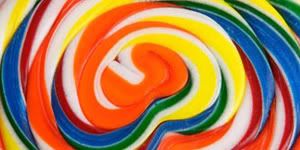Douga and genga are easy to tell apart . . . if you know what to look for. Douga is
always on white paper, and the registration number is in the top right-hand corner (unless the registration holes are on the bottom for a special filming purpose; then it's in the bottom right-hand corner).
Original genga are in white, and tend to be on thinner paper. They are also labeled, but the labeling is drawn next to the character, never in the corner.
Correction genga (susshei? Sorry, I can't remember the Japanese), are done on pink, blue, yellow, or green paper. This paper is much thinner, because it is meant to be laid on top of the original genga. That way, you see through the correction genga to the original genga so it creates one picture for the key douga-maker to trace key douga from.

Layouts tend to have the background sketched on as well. They will also have the episode number (the number after the #) and cut number (the number proceeded by a C) but no registration markings.
Keep in mind that this only applies to Japanese animation. I know nothing about American.

I'm not positive, but I'd assume that any rough sketch you come across without any labeling is just a genga with no labeling.

Genga means something like "original picture," right?

